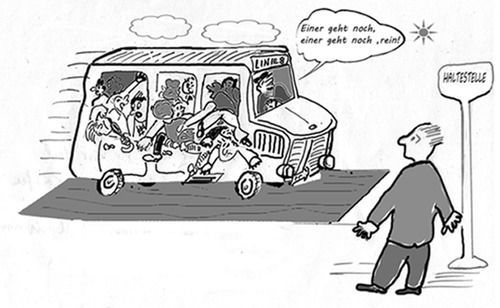#ÖPNV
Text
Durfte heute Nacht vier Stunden an der ungarischen Grenze verbringen. Es gab noch nicht mal einen Kaffeeautomaten, ich bin am Ende.
24 notes
·
View notes
Text


Berlin
Friedrichshain
U-Bahnhof Frankfurter Allee
Canon EF 35mm f/1.4L USM@Canon EOS 6D
#Canon EOS 6D#Canon EF 35mm f/1.4L USM#germany#Deutschland#Berlin#Friedrichshain#U-Bahnhof Frankfurter Allee#subway#underground#public transportation#ÖPNV#BVG#people#streetphotography#urban#city#metro#retro#vintage#monochrome#Depth Of Field#DOF#bokeh
10 notes
·
View notes
Text
Meine ÖPNV App kommuniziert den anstehenden Streik in einem sehr bedrohlichen Tonfall: Planen sie, seien sie UNBEDINGT bis [Uhrezeit] an ihrem Zielort. Danach komplette Einstellung des Fahrbetriebs (AUCH bei den Subunternehmen).
Das kann was auf den Straßen geben, wenn NICHTS fährt. More Elterntaxis. More Fahrgemeinschaften.
#j talks#warnstreik#öpnv#german stuff#wir machen den franzosen bald Konkurrenz#aber deren streikkultur ist ja noch krasser#german
7 notes
·
View notes
Text
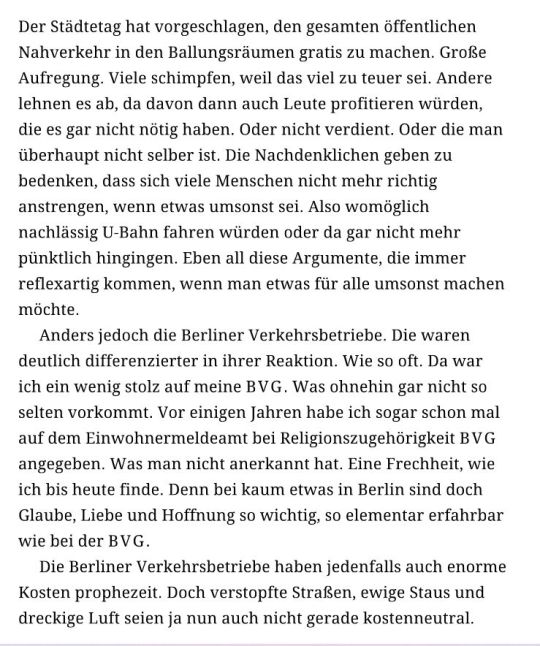


Danke, Horst Evers!
Die Geschichte stammt aus 2018. Da gab es noch kein 49-€-Ticket.
Allerdings hatten die CSU-Minister seit 2007 den Auftrag dafür. Aber ihnen fehlte die Zeit. Wegen der Maut und der Umleitung von Straßenbaugeldern nach Bayern.
11 notes
·
View notes
Text
Juni 2023
Nur der alte Mann zeigt Karte
Im Unterschied zu Kathrin Passig habe ich mich für das so genannte Deutschlandticket entschieden, gleich als es angeboten wurde. Nicht nur weil es günstiger ist als die normale Berliner Monatskarte für den ÖPNV, sondern vor allem wegen des Gewinns an Lebensqualität: In ganz Deutschland in jede U-Bahn, jede Straßenbahn und jeden Bus steigen zu können, ohne darüber nachzudenken, ob ich den passenden Fahrschein habe, ihn besser im Vorverkauf erstehe oder ob der Busfahrer auf passender Bezahlung in Münzen besteht, finde ich einen Fortschritt.
Zur Kieler Woche bin ich in Kiel und steige in den Bus, der mich zum Marinestützpunkt im Norden der Stadt bringen soll. Anders als in Berlin besteht der Busfahrer darauf, von allen das Ticket beim Einsteigen zu sehen. Ich zeige, problemlos, mein Deutschlandticket auf der Plastikkarte der Berliner S-Bahn vor.
Da bin ich der einzige. Jede/r, wirklich ausnahmslos jede/r, die/der auf der 20 Minuten langen Strecke in diesen Bus einsteigt, präsentiert das Smartphone mit seiner Fahrkarte. Elektronisch eingelesen wird weder meine Plastikkarte (mit integriertem digitalen Ticket) noch die Karte auf dem Handy; bei allem reicht der prüfende Blick des Fahrers.
Mit meiner Karte komme ich mir aber auch so ein bisschen als alter Mann vor.
Nachtrag: Eine Techniktagebuch-Leserin aus Kiel hat sich mit einer ganz anderen und ganz einfachen Erklärung gemeldet:
Es liegt (Vorsicht Spoiler) gar nicht am alten Mann!
Es ist nämlich so: In Kiel (und ich glaube sogar in ganz SH) kann man das Deutschlandticket gar nicht offline kaufen. Es geht nur über die Bahn- oder Nah-SH-App und ich kenne jede Menge Bus-und-Zug-fahr-Schulkinder, die extra fürs Deutschlandticket ein Smartphone bekommen mussten.
In der Tat, der regionale Verkehrsverbund NAH.SH sieht das Deutschlandticket ausschließlich als App auf dem Smartphone vor. In anderen Verkehrsverbünden ist das anders, zum Beispiel - wie erwähnt - in Berlin, aber auch in Hamburg: Da gibt es eine Karte mit dem gespeicherten elektronischen Ticket als Alternative.
(Thomas Wiegold)
9 notes
·
View notes
Text
Let’s debate ticket prices for public transit for a moment.
Germany is currently running a giant nation-wide experiment: In June, July and August, you can buy a ticket for 9€ per month that allows you unlimited travel through the entire country on buses, trams, metros and regional trains (not long-distance trains, except sometimes). If you already have a ticket that is valid for any of these months, its price is reduced to just 9€ for this period. This is financed by the federal government to help low-income people and to entice more people to try to commute by public transit instead of by car.
It’s been an unquestionable success, though there are some doubts whether this is really a fundamental shift that brings in lots of people who will continue to use public transit regularly, or just people who want to go on vacation or weekend trips more cheaply. Right now, there is also the question of what comes next. The association of german public transit operators, VDV, have just launched a campaign arguing for a nation-wide 69€ ticket that basically does what the 9€ ticket does, but at a price where the government doesn’t have to increase subsidies much (”only” two billion euros per year) over what they are right now.
To that, there are a number of very common reactions. The first, of course: Nice. Then there are people arguing that this makes their tax payer money go to others; I’m going to ignore them here. But there are also a lot of people arguing that this is too much. And others yet are arguing for public transport to be free entirely.
The price of 69€ is both incredible and way too high, depending on your point of view. I have no idea how they reached this number specifically, and whether they were aware of the joke or even banking on it to get more recognition.
But for context: I have a monthly ticket that normally costs like 55€ just for my city (and I barely ever use it…), so this slight increase in order to get the full country is basically negligible. I’d buy this ticket immediately. The closest thing you can get to it, the BahnCard 100 which gives you free travel in all trains (including long-distance) costs 4144€ annually, or about 345€/month, so this is a drastic improvement.
However, if you don’t already have a monthly ticket, and especially if you’re already paying for your car, then the 69€ may be a steep ask. And so a lot of people say it should be lower, or even free.
Free public transit is a topic that is being debated very, very widely and hotly. It’s obviously appealing, but it also has a number of obvious problems. The first problem is that it costs money; the lost ticket revenues have to be replaced by taxes. The second problem is that it costs even more money. Free transit will mean much more people using buses and trains instead of cars (but also instead of walking or biking, in particular in bad weather). People might also make new trips they wouldn’t have if it hadn’t been for new transit. All that means you will need much more buses, trains and corresponding personnel and infrastructure. As a result, your transit system becomes much more expensive to run just as you’ve cut off a major revenue stream.
The 9€ ticket already has led to massive overcrowding in trains, while revenues didn’t match. The federal government is paying the states the expected difference in normal revenue, but not the additional cost for running more trains and buses. It seems like the 69€ ticket is designed to offer a good balance here.
All those money things are issues that can be overcome with political will, but that’s not exactly easy. And even if we assume the government is willing to pay that money: Is that the best use of this money? Free transit first and foremost helps those who already live near good transit lines. If a transit journey takes you two hours instead of ten minutes by car, you’ll take the car even if transit is free. Investing the money in better service and denser networks may be more beneficial overall in getting people to switch from cars.
That’s why the commonly accepted wisdom by most transit experts is that free public transit is not a good idea. Personally, though, I am not quite so negative about it.
For one, in all the discussion, people forget that the cost and effort to a passenger is not just the fare; they also have to understand your network and your fare paying rules. What tickets are available, and when are they valid? Do you go by zone, distance or flat fare? I’ve seen cities (Hanover, fuck that place) that have different zones depending on whether you buy a single ticket or an all-day ticket. Free transit makes transit easier to understand, and that is a significant benefit that I think we don’t talk about enough. The 9€ ticket does the same, of course, and so does the 69€ ticket, although both of these still allow for cheaper single-use tickets whose rules you would have to learn again.
The real important issue is the one unspoken assumption I’ve made here throughout, though: That everybody has the option of going by car instead, and in particular, is already paying for a car. There are a lot of people for whom this isn’t true, and for whom free or 9€/month public transit can drastically transform their lives
If you are out of work or at the lowest end of the german low wage sector, you get government assistance under the infamous Hartz IV program, where smart people have calculated the least amount of money to live reasonably, and then politicians have slashed that number, and it can get slashed more if the state agency thinks you’re not trying hard enough to get a job. It’s not great.
In these calculations, you’re assigned about 20€ per month for travel, and that includes all travel: To job interviews, doctors, government agencies, but also to friends and family. This figure is ridiculous; as you may recognise, it’s far from enough to travel by bus every workday in my home cities (some regions offer cheaper tickets to Hartz IV recipients, but I think mine doesn’t), let alone friends or family who live elsewhere, and it’s not enough to buy a future 69€ ticket either. Many people who do live in Hartz IV say that travel is essentially entirely impossible, since they need these allocated 20€ for other things, as the base rate is too low.
That means 69€ is a really great price for some, primarily for those who already use public transit. It’s going to be much less useful for people who do all of their travel by car, and it’s not going to be useful at all for the people who are currently too poor to travel at all. The proposal does say that cheaper tickets for poor people should be considered by next year, and yes, I do agree with that, but I think it would be even better if we could consider them right now already.
I do think the 69€ is a step in the right direction, but I think we need to go further in making public transit cheaper.
13 notes
·
View notes
Text
49-Euro Ticket ab heute für 39, ab Juli für 34 Euro
Das Deutschland-Ticket gibt es jetzt zu kaufen. Gültig ist es vom 1. Mai an. Fragen und Antworten rund um lokale Besonderheiten des Tickets behandelt das Tagblatt in diesem Artikel.
“Das deutschlandweit im Regionalverkehr gültige Ticket kostet regulär 49 Euro monatlich. Für alle Menschen, die ihren Wohnsitz in Tübingen oder in einem der Tübinger Teilorte haben, ist es aber schon für 39 Euro zu…
View On WordPress
2 notes
·
View notes
Text
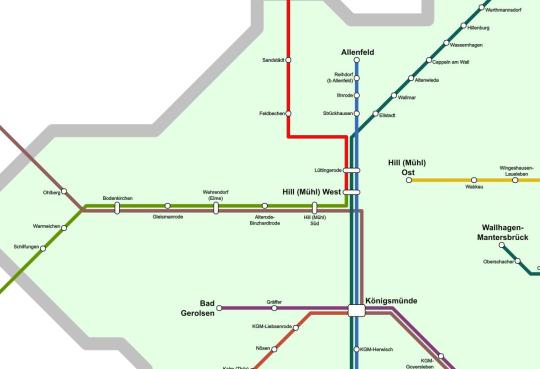
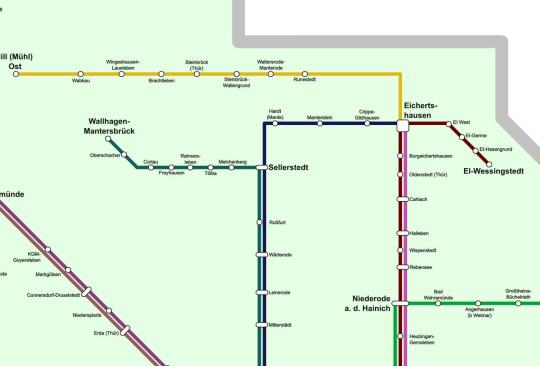
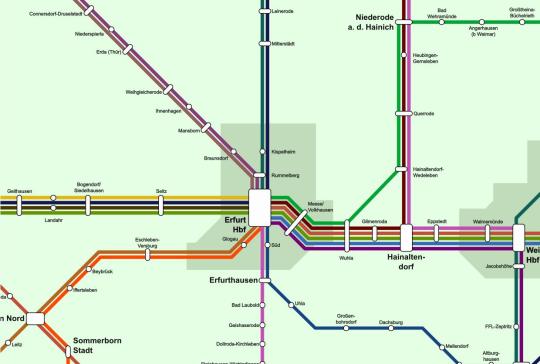



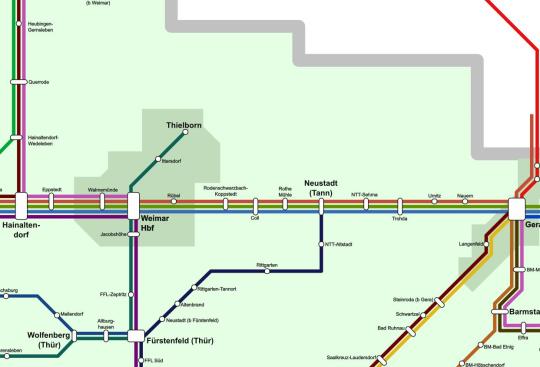


The train network of a fictional version of the German state of Thuringia I conceptualised once! Its map will be following.
-
Das Zugnetz einer fiktionalen Version des Bundeslandes Thüringen. Die zugehörige Karte dieser meinigen Version des Bundeslandes wird folgen. Bei der Benennung der Orte und anderer Gegebenheiten habe ich versucht, mich onomastisch/etymologisch an realen Gegebenheiten zu orientieren (z.B. den Anstieg an slawischen Ortsnamen in Richtung Osten oder die Häufungen von -stedt und -rode/-roda in bestimmten Gegenden).
#geography#transit map#geographie#liniennetz#graphic design#aspiring artist#grafikdesign#transit#öpnv#nahverkehr#public transit#thüringen#ostdeutschland#thuringia#erfurt#weimar#gera#thüringerwald#mitteldeutschland
3 notes
·
View notes
Text
In rumänischen Zügen wird man übrigens regelmäßig von Autos überholt.
28 notes
·
View notes
Photo
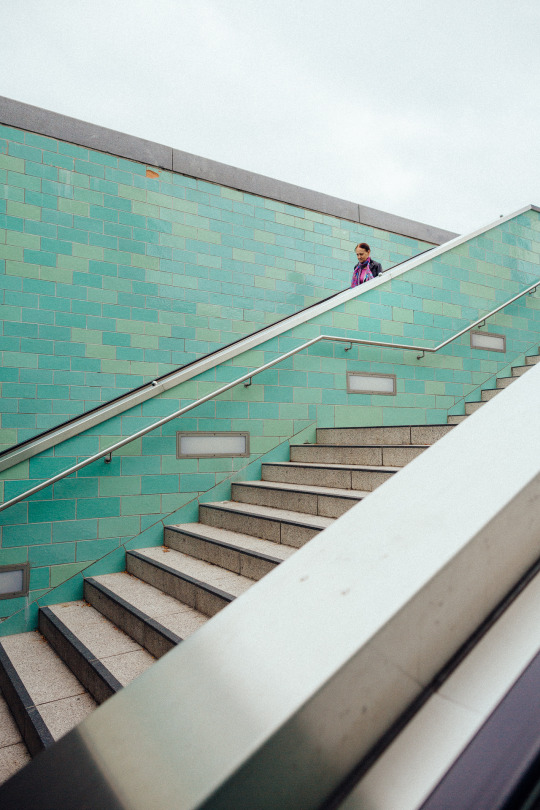
Berlin
Mitte
U-Bahnhof Alexanderplatz
Canon EF 24mm f/1.4L II USM@Canon EOS 5D Mark III
#Canon EOS 5D Mark III#Canon EF 24mm f/1.4L II USM#germany#Deutschland#Berlin#Mitte#Alexanderplatz#U-Bahnhof#subway#underground#public transportation#ÖPNV#BVG#people#streetphotography#urban#city#metro#retro#vintage#colours#colors#Farben
38 notes
·
View notes
Text
Straßenbahn: Wer bremst die Tram M1 aus? Wann wird die M1 schneller und wann fährt sie weiter?, aus Senat
21.03.2024
Vorbemerkung der Abgeordneten:
Die #Straßenbahnlinie #M1 hat aufgrund ihrer hohen Fahrgastzahlen und vielen Umstiegsmöglichkeiten eine große Bedeutung für den innerstädtischen Verkehr, ist aber wegen häufiger Zeitverluste an Lichtsignalanlagen (LSA) hinsichtlich der #Durchschnittsgeschwindigkeit eine sehr langsame Tramlinie.
Frage 1:
Wie haben sich bei der Linie M1 nach…
View On WordPress
#Durchschnittsgeschwindigkeit#Durchschnittswert#exklusiven#Fahrstreifen#Fahrweg#Fahrzeuge#frequentierte#Gleiskörper#Haltestelle#Knotenpunkte#LSA#M1#ÖPNV#Optimierungspotenzial#Pankow#Pastor#Radverkehr#Straßenbahnlinie#Straßenrand#Tram#Trassierung#Verlustzeiten#Vorrang#Weinbergsweg
0 notes
Text
2. Mai 2022
Ich bin eben nicht nur eine Nummer
Auf unserer Israel-Reise sind wir in Haifa angekommen. Unsere Wäschesituation sieht so aus, dass es ganz gut wäre, einen Waschsalon aufzusuchen. Laundry HaMahbessa macht einen guten Eindruck und ist vom Hotel aus mit dem Bus ohne Umsteigen zu erreichen.
An der Hotelrezeption fragen wir, wie das mit dem ÖPNV in Haifa so geht. Ja, sagt man uns, da bräuchten wir ne App. Hier nähmen alle Moovit. Oder eine Rav Kav-Karte (gibt es auch als App). Ich frage, weil ich das aus Jerusalem so kannte, ob man nicht auch an einem Automaten schlicht ein Papierticket kaufen kann. Ne, das ginge nicht. Nur elektronisch. Zu diesem Zeitpunkt ahne ich schon, dass das nichts wird, allein schon, weil wir zu zweit sind, aber nur ein Handy mit Internet-Roaming haben und ja vermutlich jeder sich mit seinem Handy im Bus ein- und ausloggen muss.
Weil ich das alles einigermaßen verstörend finde, suche ich online nach Infos zum Public Transport Haifa. Da heißt es:
Despite being Israel’s third largest city, Haifa’s public transport system is the most advance in the country, making it easy for visitors to get from uptown to downtown, and find their way around the city.
Und weiter:
Always buy a Rav Kav.
Weil das mit dem Kauf der Rav Kav-Karte mangels entsprechendem Laden schwierig ist, probiere ich, die App zu installieren. Das ist ja wohl auch eigentlich noch “advanceter” als die Karte. Ich soll mich natürlich registrieren. Neben meinen Kreditkarten-Daten will man auch meine Owner ID (hab ich nicht) oder Passport number (hab ich) wissen.

Nun besteht diese “Nummer” in meinem deutschen Reisedokument aus Ziffern UND Buchstaben. Das Eingabefeld in der App erlaubt aber nur Ziffern. Vermutlich hat die israelische Passnummer eben nur Ziffern.
Mich bei Rav Kav anzumelden, klappt also nicht. Zu Fuß ist es uns mit der Wäsche zu weit. Also fahren wir mit dem Auto. Wir finden sogar einen Parkplatz. Der ist zwar gebührenpflichtig, aber der Automat nimmt auch Münzen. Das mit dem Wäschewaschen klappt dann innerhalb der bezahlten Parkzeit und kann wie ansonsten fast alles in Israel berührungslos mit der Kreditkarte bezahlt werden.
Ein paar Tage später in Tel Aviv, wir haben unseren Leihwagen inzwischen abgegeben, fahren wir viel mit dem Bus. Unser Besuch fällt nämlich aufs Wochenende. Am Shabbat fahren spezielle Busse umsonst, also von Freitag Nachmittag bis Samstag Nachmittag. Das ist einfach und für uns niederschwellig genug. Und ich kann die Abfahrtzeiten mit der immer noch installierten Moovit-App herausfinden.
André Spiegel merkt noch an:
In Göteborg kann man sich in der ÖPNV-App auch nur mit einer schwedischen Bürgernummer registrieren. Ansonsten muss man halt ohne Account, nur mit Gästezugang fahren, und das geht dann auch nur mit einer europäischen Kreditkarte.
Vergleichbare Probleme sind also international gut verteilt.
(Markus Winninghoff)
#Markus Winninghoff#Haifa#ÖPNV#App#Rav Kav#Kreditkarte#Buchstaben#Zahlen#Passport number#Tel Aviv#Shabbat#Göteborg#André Spiegel#Moovit#Pass#Israel#Schweden#Bezahlverfahren#Ticket
6 notes
·
View notes
Text
Ordnungswidrigkeit statt Straftat Kein Gefängnis mehr fürs Schwarzfahren
Stand: 25.03.2024 12:35 Uhr
Eine Gefängnisstrafe wegen wiederholten Schwarzfahrens gibt es in Köln nicht mehr. Auch der Bund plant Regelungen, das Fahren ohne Ticket zu entkriminalisieren. Gefängnisstrafen treffen derzeit vor allem Ärmere.
0 notes


